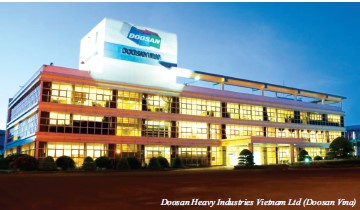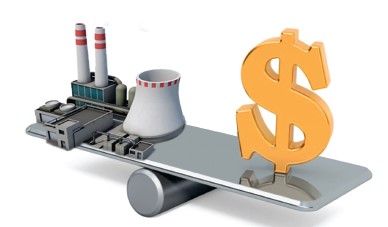Considering the numerous developing economies, it raises the question of whether Vietnam will contemplate nuclear energy in the future. The relationship between the United States and
Vietnam is multifaceted, encompassing political, economic, and cultural aspects. Since 1995, there have been notable transformations in this relationship.
As on date though, Vietnam does not have any operational nuclear power plants.
In the past, Vietnam had shown keen interest in developing nuclear energy as a means to meet its growing electricity demand, reduce its reliance on fossil fuels, and mitigate climate change. The
Vietnamese Government had planned to build the country’s first nuclear power plant in NinhThuan province with the assistance of foreign partners.
Vietnam signed agreements with Russia and Japan to build nuclear power plants, and the NinhThuan 1 Nuclear Power Plant was scheduled to be operational by 2028. However, in 2016, Vietnam decided to
postpone the construction due to economic concerns and changes in the country’s energy development plan. The decision was influenced by factors such as high costs, safety concerns, and public opposition.
Since then, Vietnam has shifted its focus more towards renewable energy sources such as hydropower, solar power, and wind power. The Vietnamese Government has set renewable energy targets and has been actively promoting the development of these clean energy sources.
This general target was verified in a nuclear power development plan approved by the government in August 2007, with the target being raised to an aggregate of 8000 MWe nuclear by 2025. A general law on nuclear energy was passed inmid-2008, and a comprehensive legal and nonsupervisory frame was also being developed. Two reactors totalling 2000M We were proposed at PhuocDinh in the
southern NinhThuan fiefdom, as well as a farther binary unit 2000 MWe factory at VinhHai. These two shops were to be followed by a farther 6000 MWe by 2030. Both locales were chosen grounded
particularly on geological felicity on the seacoast.
A high-demand projection recommends the installation of 8,000M We (megawatts electrical) by 2025 and 15,000 MWe (10% of the total) by 2030, distributed across eight locations within five industries. This plan includes the addition of four additional units to the initial two locations, as well as the establishment of six additional units at three or four centralized sites in QuangNgai (DucThang or DucChanh), BinhDinh (Hoai My), and PhuYen(Xuan Phuong).
Atomstroy export, Westinghouse, EdF, Kepco, and China Guangdong Nuclear Power Group (CGNPC) have all expressed significant interest in supplying the initial two twin-unit nuclear power plants. In 2010, unverified reports suggested that the Japanese Government, along with Tepco and other companies, offered an $11 billion contract for the project. Additionally, a consortium comprising
Mitsubishi, Toshiba, and Hitachi also made an offer. It is worth noting that the power plants were intended to be state-owned under Power of Vietnam (EVN), without any private equity involvement.
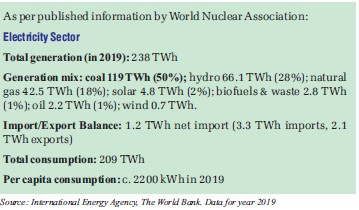
Formerly Proposed Nuclear Power Reactors
In July 2011, the Government of Vietnam released a master plan outlining the development of the NinhThuan 1&2 Nuclear Power Plants. The plan proposed a total of eight reactors in the 1000 MWeclass, with one reactor scheduled to come online each year from 2020 to 2027. Additionally, two larger reactors were planned to be operational by 2029 at a centralised location. The Ministry of Industry & Trade (MOIT) was assigned the responsibility for implementing the actual projects, while the Ministry of Science & Technology (MOST) supported the programme by creating a master plan and providing guidance.
In January 2014, the Vietnamese government announced a delay of up to four years in the development of nuclear power, citing ongoing negotiations related to technology and financing. The delay was also attributed to the recommendation of the International Atomic Energy Agency (IAEA), which advised additional time for thorough preparation.
Subsequently, in January 2015, the Vietnam Atomic Energy Agency (VAEA) announced another significant delay, pushing the start of construction to around 2019. These delays were necessary to ensure
comprehensive readiness and proper planning for the nuclear power projects.
In March 2016, the Vietnamese Government announced that the commissioning of the first reactor was scheduled for 2028. This revised timeline aligned with the modifications made to the National Nuclear Power Development Plan, which extended until 2020. The plan anticipated that by 2030, approximately 4,600 MWe of nuclear capacity would be operational in Vietnam.
However, in November 2016, the National Assembly made a resolution to indefinitely postpone the plans for the two nuclear power plants due to the prevailing financial conditions in Vietnam at that time, as well as lower demand projections. Instead, the focus shifted towards the development of 6 GWe (gigawatts electrical) of liquefied natural gas (LNG) and coal power generation by 2030, driven by short-term cost considerations associated with these fuels. The planal so included the importation of electricity, particularly from Laos, and the utilisation of renewable energy sources to complement the domestic power supply.
In an earlier development, in February 2014, Doosan Heavy Industries Vietnam Ltd (Doosan Vina) achieved ASME certification, making it the first company in Southeast Asia to be certified for the production of nuclear components.
The company, Doosan Heavy Industries Vietnam Ltd (Doosan Vina), was established in 2007. In March 2022, the Ministry of Industry and Trade released a draft development plan proposing the inclusion of Small Modular Reactors (SMRs) in Vietnam’s energy mix after 2030. The plan aimed to incorporate SMRs as a future energy source.
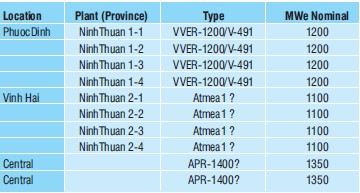
In June 2022, the Minister of Industry and Trade addressed the National Assembly, emphasising that the development of nuclear power is a non going and inevitable trend globally. While
the Government remains committed to increasing renewable energy capacity, he highlighted the necessity of having a stable energy source for the country. This suggests that despite the focus on renewables, there is recognition of the need for a reliable and consistent energy supply, potentially opening the door for future consideration of nuclear power or other stable energy sources.
NinhThuan 1: PhuocDinh (Russia)
A pre-feasibility study for this plant carried out by the MOIT was approved by the National Assembly in November 2009, and a comprehensive feasibility study followed. In May 2010, the Prime
Minister established the NinhThu an Nuclear Power Project. The NinhThuan Project Management Board functioned under EVN.
In October 2010, an intergovernmental agreement was signed for Atomstroy export to build the NinhThuan 1 Nuclear Power Plant, using two VVER- 1000 reactors based on those at Tianwan in China. However, in October 2014, it was decided to use the later AES-2006 nuclear plants with VVER-1200 reactors. It was to be constructed as a turnkey project. In July 2015 EVN and NIAEP-Atomstroyexport
signed a general framework agreement for construction of the first unit, with the actual VVER- 1200/V-491 reactors to be supplied by Atomproekt based in St Petersburg. NIAEP-ASE is the parent company of Atomenergoproekt (AEP) which was involved in the design.
Russia’s Ministry of Finance was set to fund a minimum of 85% of the plant and handle the fuel supply and retrieval of used fuel through out it so prerational lifespan, in accordance with the
standard Russian policy for nonnuclear-weapons States. In November 2011, an agreement was signed with the Russian government’s state export credit bureau to provide financing of up to $9 billion. Furthermore, a separate agreement, amounting to a $500 million loan, was made for the establishment of the Centre for Nuclear Energy Science & Technology (CNEST), a joint effort by Rosatom and MOST. It should be noted that all financing arrangements were planned to be conducted in Russian roubles and Vietnamese dong, rather than US dollars. In 2019, a Memorandum of Understanding (MoU) was signed between Rosatom and Vietnam’s Ministry of Science and Technology to facilitate the implementation of CNEST.
In 2014, 344 Vietnam ese undergraduate and graduate students were studying in Russia, to prepare for the project, and 150 engineers were helping with the construction of Rostov nuclear plant in Russia. Early in 2017, 28 Vietnamese became the first international graduates of a sixy ear course on nuclear technology at Russia’s National Research Nuclear University MEPhI . Forinternation a l
ventures, Rosatom arranges both university and in-company training for nationals.
The initial schedule was for construction to start in 2014 and operation from 2020, but commencement was delayed to 2019, with six years’ construction envisaged. Considerable work was done at the site before the project’s indefinite postponement, including relocating two villages with much upgrading of facilities and infrastructure.
Earlier in 2012,Rosatom helped establish a Nuclear Industry Information Centre (NIIC) at the Hanoi University of Science & Technology (HUST) based on others in 17 Russian regions. The Hanoi NIIC is the first of six international centres (Astana, Dhaka, Hanoi, Mersin, Minsk, Istanbul). It catered for 1600 visitors per month, 1300 of these being school students, and 90% being from outside Hanoi.
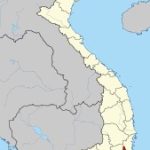
NinhThuan 2: Vinh Hai (Japan)
In October 2010, an intergovernmental agreement with Japan was signed for construction of a second nuclear power plant at VinhHai in NinhThuan province, with its two reactors to come on line in
2024-25. The following month the Government signed a further accord with Japan on this, and Japan’s Ministry of Economy, Trade and Industry (METI), said that Japan Atomic Power Co. (JAPC) and the International Nuclear Energy Development of Japan Co. Ltd. (JINED), would work with EVN on the project, which was to involve financing and insurance of up to 85% of the total cost. JINED is a consortium of Japan’s METI, nine utilities (led by Chubu, Kansai & Tepco) and three manufacturers (Mitsubishi Heavy Industries, Toshiba and Hitachi). The intergovernmental agreement took effect from January 2012.
In February 2011, JAPC signed an agreement with EVN to advance the feasibility study, and in September, it signed a contract with EVN to provide consulting services to help with site selection and an 18-month, $26 million feasibility study, including technology selection with economic and financial analysis, funded by the Japanese government. The following day an MoU was signed between EVN and JINED to progress the design, construction and operation of the plant. EVN listed six criteria to apply, including late-model reactors, stable supply of fuel, support for local industry and education of staff, and financial support. Japan committed to train about 1000 staff for NinhThuan 2, and in January 2015, Westinghouse committed to train staff, too.
Vinh Hai is on Cam Ranh Bay, about 20 km north east of PhuocDinh. In October 2011, a less-formal arrangement for cooperation in construction was signed, and work on the infrastructure for construction was underway. JAPC’s feasibility study for EVN was completed in May 2013. Adecision on technology was not made, though PWR appeared likely, and Mitsubishi earlier said that if it is
PWR then the reference plant would be Hokkaido’s Tomari 3, an 866 MWe unit. Toshiba through Westinghouse was keen to supply AP1000 units. However, in September 2015, industry sources said Atmea1 was likely to be chosen.
South Korea and Other Links
In November 2011, the Presidents of Vietnam and South Korea approved a joint plan on nuclear power plant construction which they agreed to use as a basis for future cooperative projects. In March 2012, a nuclear cooperation agreement was signed to take this forward, with a one-year feasibility study on constructing of a Korean plant. In June 2013, a joint preliminary feasibility study commenced “for nuclear plant development worth $10 billion”, and both governments agreed to cooperate further on the development project.
A nuclear cooperation agreement was signed with Russia in 2002, and since 2006, others were signed with France, China (in particular with CGNPC), South Korea, Japan, USA and Canada. In 2007, there was an agreement between the US Department of Energy’s (DoE’s) National Nuclear Security Administration (NNSA) a n d V i e t n a m ‘ s M O S T f o r cooperation and information exchange on the peaceful uses of nuclear energy. A further nuclear agreement with the USA was signed in March 2010, followed by an initialled full cooperation and commercial trade agreement in October 2013. This agreement was subsequently approved by Congress in May 2014, granting US companies the opportunity to conduct business with Vietnam. Additionally, in June 2010, the Japan Atomic Energy Agency entered into an agreement with the Vietnam Agency for Radiation and Nuclear Safety & Control (VARANS) for the development of infrastructure pertaining to safeguards and nuclear security i n r e l a t i o n t o n u c l e a r nonproliferation.
Uranium and Fuel Cycle
Since 2010, the Department of G e o l o g y & Mi n e r a l s u n d e r Vietnam’s Ministry of Natural Resources & Environment has been conducting an evaluation of a uranium deposit located in Quang Nam province. It is e s t ima t e d t h a t t h e d e p o s i t contains approximately 7,000 tonnes of uranium (tU) with an ore grade of 0.05%. In 2010, the C a n a d i a n c o m p a n y N W T Uranium Corp was invited to assist in assessing the prospects of the deposit.
Vi e t n am’ s p l a n s c a l l e d f o r importing all the fuel required for reactors. As stated in the 2010 a g r e e m e n t w i t h t h e U S A , Vietnam expressed its intention to rely on international markets for the supply of nuclear fuel and to refrain from pursuing domestic enrichment capabilities.
Research and Development
Rosatom was working with MOST to establish the Centre for N u c l e a r E n e r g y S c i e n c e & Technology (CNEST) under VINATOM, based in Hanoi. Agreements were signed on this in June 2017 and in 2019. A multipurpose 15 MWt VVR research reactor was planned, as well as a complex of laboratories and e n g i n e e r i n g i n f r a s t r u c t u r e . Rosatom has said that deferral of
plans for nuclear power will not affect its R&D commitment. However, due to the intended use of the research reactor for training staff for the nuclear power programme, it is now unlikely to move forward.
An earlier nuclear cooperation agreement with Russia relates principally to Vietnam’s 500 kW Da LatResearch Reactor in Lam Dong province, built in 1980, and c o m m i s s i o n e d 1 9 8 4 . T h i s replaced an earlier US TrigaMkII reactor, which started in 1963, but was dismantled by the USA in the early 1970s. In 2007, the USA assisted in the conversion of the Da Lat reactor to operate using low-enriched fuel. The reactor is currently managed by VINATOM; however, it is scheduled for shutdown around 2025. Situated approximately 300 km north of Ho Chi Minh City, the Da Lat reactor has played a significant r o l e i n Vi e t n a m ‘ s n u c l e a r activities.
The Dong Nai Research Centre is located in the south, at Ho Chi Minh City (Saigon), and was e x p e c t e d t o a s s u m e m o r e importance under CNEST. The Institute of Nuclear Technology is
situated in the north.
In late 2014 Hanoi University of Science and Technology and Electric Power University signed agreements with GE Hitachi N u c l e a r E n e r g y ( G E H ) t o cooperate in nuclear engineering.
Early in 2015, GEH also signed an agreement with VARANS to p r o m o t e h u m a n r e s o u r c e s training and development in the field of nuclear safety analysis for boiling water reactors. In October 2015, another agreement was signed between GEH (General Electric Hitachi) and VAEA (Vietnam Atomic Energy Agency) with the aim of enhancing their understanding of light water reactor technology, nuclear p r o j e c t m a n a g e m e n t , a n d p r o v i d i n g t r a i n i n g t o s t a f f members.
Organisation and Regulation
Vietnam’s new Atomic Energy Law was passed in June 2008 and came into effect early in 2009. Under this, a national nuclear safety commission responsible to the Prime Minister for safety and licensing was established in July 2010.
The Vietnam Atomic Energy Commission/Agency (VAEA) was established in 1976 as part of the Ministry of Science & Technology ( M O S T ) . To o v e r s e e t h e implementation of atomic energy
initiatives, a national steering committee was formed in May 2010 by the Prime Minister. This c o m m i t t e e , s e r v i n g a s t h e Implementing Organisation, includes representatives from
v a r i o u s m i n i s t r i e s a n d government organisations.
The Vietnam Atomic Energy Institute (VINATOM), a part of MOST, is responsible for R&D, technical support, personnel training and technical services, including the Da Lat research reactor.
T h e V i e t n a m A g e n c y f o r Radiation and Nuclear Safety & Control (VARANS), also part of MOST is the regulator. In June 2008, the US Nuclear Regulatory Commission and VARANS signed
a cooperation agreement to share technical information on nuclear energy as well as exchanging information about regulations, environmental impact and safety of nuclear sites. This was the primary formative influence on VARANS, though it has also actively cooperated with NISA ( J a p a n ) a n d Ro s t e c h n a d s o r (Russia). In February 2015, VARANS (Vietnam Agency for Radiation and Nuclear Safety & C o n t r o l ) e n t e r e d i n t o a n agreement with GE Hitachi Nuclear Energy (GEH) for the latter to provide training and development in the field of n u c l e a r s a f e t y a n a l y s i s , specifically for boiling water reactors.
In May 2013, the Prime Minister announced the establishment of a new National Council for Atomic E n e r g y D e v e l o p m e n t & Application to identify strategies and priorities and advise the Government. It was to coordinate m i n i s t r i e s , a g e n c i e s , g o v e r n m e n t a l b o d i e s a n d localities in developing nuclear energy and “realising” nuclear power programmes. It was also to take on a role in international nuclear cooperation activities w i t h o r g a n i s a t i o n s a n d individual countries.
Non-Proliferation
Vietnam’s safeguards agreement with the International Atomic Energy Agency (IAEA) under the Treaty on the Non-Proliferation of Nuclear Weapons (NPT) came i n t o e f f e c t i n 1 9 9 0 . T h e
Additional Protocol has been in force since 2012.


